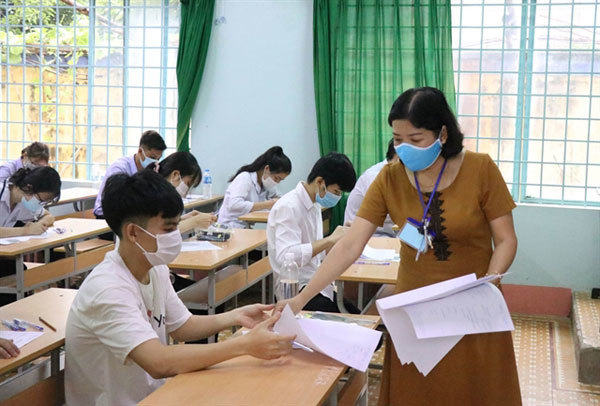Students in COVID-19-hit localities take national exam
ABO/VNS - More than 26,000 students who were either in quarantine or live in areas where social distancing measures are in place due to COVID-19 sat the national high school examination on Thursday.
This year, for the first time, the exam has been organised in two phases due to the COVID-19 pandemic.
About 867,000 candidates finished the first phase on August 10.
Their peers who could not sit the first phase of the exam attended the second phase, taking the literature test on Thursday morning, maths on Thursday afternoon, social or natural sciences on Friday morning and foreign languages on Friday afternoon.
Examination councils were set up in Hanoi, Da Nang, Quang Nam, Dak Lak, Thua Thien-Hue, Quang Ngai, Lang Son, Quang Tri, Thai Binh, Hoa Binh and Bac Giang for the 26,000 students from 27 cities and provinces in this phase.
Figures from localities showed more than 26,160 students were expected to attend the second phase, accounting for 2.91 per cent of the total registered for the exam.
 |
| An exam supervisor gives questions to students who sit for the second phase of the national high school graduation exam at Chu Van An High School in the Central Highland city of Buon Ma Thuot, in Dak Lak Province. |
Of those, nearly 11,000 students are from the central city of Da Nang, the country’s largest outbreak, along with more than 9,200 from the neighbouring Quang Nam Province, 5,400 from Dak Lak and 355 from Quang Ngai Province.
Inspecting the exam organisation in Quang Nam on Thursday morning, Mai Van Trinh, director-general of the Quality Control Department under the Ministry of Education and Training, said the tests used for the first phase and second phase of the exam were similar and all included content the students studied at school.
“The tests were developed on the same matrix and from the same question bank as the first phase so the tests’ difficulty levels are the same to ensure quality among all students regardless of whether they attended the first or second phase,” Trinh said.
Only after the results of the second phase are announced on September 16 can universities/colleges announce the minimum scores to enrol students.
Nong Thi Mung, a 12th grader of Dinh Lap High School in the northern province of Lang Son, said that as a candidate in the second phase of the exam, she was under more pressure because her peers across the country knew their results and the results were quite high.
In Da Nang, on August 31, nearly 11,000 candidates who were set to attend the second phase and about 2,700 staff serving the exam were tested for the coronavirus. All of them tested negative for SARS-CoV-2, according to the city’s Centre for Diseases Control.
The city also arranged a separate exam place at Vo Chi Cong High School in Ngu Hanh Son District for candidates who are suspected to have COVID-19.
During the exam, students identified as F1 for having close contacts with confirmed COVID-19 cases will be taken to the exam place by ambulance while students identified as F2 for having contact with F1 people or living in locked-down areas will be taken to the exam place by coaches.
Vice director of the city’s Education and Training Department Tran Nguyen Minh Thanh said F1 students and testing supervisors had to wear protective equipment during the exam while F2 students must wear face masks and clean their hands before entering exam rooms.
“Those who work as testing supervisors at rooms where F1 students sit will self-quarantine at home for 14 days,” Thanh said, adding that all exam papers at Vo Chi Cong High School exam would be disinfected before mixed with papers from elsewhere.
Those who touch the papers to separate the answers and candidates’ personal information will also self-quarantine at home after finishing their work.
As many as 98.34 per cent of students who sat the first phase of the exam qualified for graduation, an increase of nearly four percentage points from a year earlier, according to the results the Education and Training Ministry announced on August 27.
The graduation rate was higher because the exams were aimed to assess whether students were eligible for graduation, not at finding outstanding graduates, in the context that schools in Vietnam were closed for three months due to the pandemic.
In 2019, the high school graduation rate nationwide was at 94.06 per cent, down 3.51 percentage points compared to 2018.
(Source: VNS)
 về đầu trang
về đầu trang







